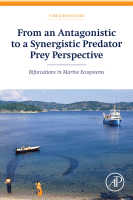Browse content
Table of contents
Actions for selected chapters
- Full text access
- Book chapterAbstract only
Chapter 1 - Introduction
Pages 1-9 - Book chapterAbstract only
Chapter 2 - Repeated Incidents of Abrupt and Persistent Recruitment Failures in Gadoids in Relation to Increasing Eutrophication, 1919–2001
Pages 11-37 - Book chapterAbstract only
Chapter 3 - Causes of Variation in Abundance, Growth, and Mortality in 0-Group Gadoids After Settlement and a Hypothesis Underlying Recruitment Variability in Atlantic Cod
Pages 39-62 - Book chapterAbstract only
Chapter 4 - Growth and Mortality in Settled Atlantic Cod in Relation to Diet—Evidence for a Recruitment Mechanism
Pages 63-94 - Book chapterAbstract only
Chapter 5 - Bifurcations in Marine Ecosystems: Concurrent Recruitment Collapses in Gadoid Fishes and Changes in the Plankton Community
Pages 95-116 - Book chapterAbstract only
Chapter 6 - Predator-Prey Synergism in Plankton
Pages 117-147 - Book chapterAbstract only
Chapter 7 - Ecological Implications of Predator-Prey Synergism in Marine Ecosystems
Pages 149-173 - Book chapterAbstract only
Chapter 8 - Variability Enhancing and Variability Dampening Mechanisms in Marine Ecosystems
Pages 175-206 - Book chapterNo access
Index
Pages 207-212
About the book
Description
From an Antagonistic to a Synergistic Predator Prey Perspective: Bifurcations in Marine Ecosystems is a groundbreaking reference that challenges the widespread perception that predators generally have a negative impact on the abundance of their prey, and it proposes a novel paradigm — Predator-prey Synergism — in which both predator and prey enhance abundance by their co-existence. Using this model, the text explains a number of issues that appear paradoxical in the case of a negative predator-prey relationship, including observed ecosystem bifurcations (regime shifts), ecosystem resilience, red tides in apparently nutrient depleted water, and the dominance of grazed phytoplankton over non-grazed species under high grazing pressure. This novel paradigm can also be used to predict the potential impact of global warming on marine ecosystems, identify how marine ecosystem may respond to gradual environmental changes, and develop possible measures to mitigate the negative impact of increasing temperature in marine ecosystems. This book approaches the long-standing question of what generates recruitment variability in marine fishes and invertebrates in an engaging and unique way that students and researchers in marine ecosystems will understand.
From an Antagonistic to a Synergistic Predator Prey Perspective: Bifurcations in Marine Ecosystems is a groundbreaking reference that challenges the widespread perception that predators generally have a negative impact on the abundance of their prey, and it proposes a novel paradigm — Predator-prey Synergism — in which both predator and prey enhance abundance by their co-existence. Using this model, the text explains a number of issues that appear paradoxical in the case of a negative predator-prey relationship, including observed ecosystem bifurcations (regime shifts), ecosystem resilience, red tides in apparently nutrient depleted water, and the dominance of grazed phytoplankton over non-grazed species under high grazing pressure. This novel paradigm can also be used to predict the potential impact of global warming on marine ecosystems, identify how marine ecosystem may respond to gradual environmental changes, and develop possible measures to mitigate the negative impact of increasing temperature in marine ecosystems. This book approaches the long-standing question of what generates recruitment variability in marine fishes and invertebrates in an engaging and unique way that students and researchers in marine ecosystems will understand.
Key Features
- Introduces a new paradigm, Predator-prey Synergism, as a building block on which to construct new ecological theories. It suggests that Predator-prey Synergism is important in some terrestrial ecosystems and is in agreement with the punctuated equilibria theory of evolution (i.e., stepwise evolution).
- Suggests a general solution to the recruitment puzzle in marine organisms
- Proposes a holistic hypothesis for marine spring blooming ecosystems by considering variability enhancing and variability dampening processes
- Asserts that fisheries will induce variability in marine ecosystems and alter the energy flow patterns in predictable ways
- Introduces a new paradigm, Predator-prey Synergism, as a building block on which to construct new ecological theories. It suggests that Predator-prey Synergism is important in some terrestrial ecosystems and is in agreement with the punctuated equilibria theory of evolution (i.e., stepwise evolution).
- Suggests a general solution to the recruitment puzzle in marine organisms
- Proposes a holistic hypothesis for marine spring blooming ecosystems by considering variability enhancing and variability dampening processes
- Asserts that fisheries will induce variability in marine ecosystems and alter the energy flow patterns in predictable ways
Details
ISBN
978-0-12-417016-2
Language
English
Published
2014
Copyright
Copyright © 2014 Elsevier Ltd. All rights reserved.
Imprint
Academic Press
